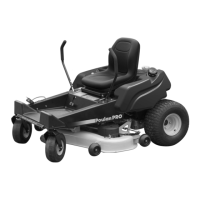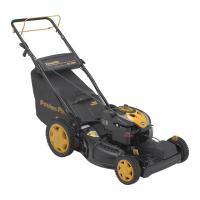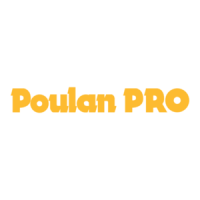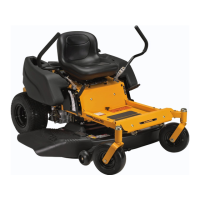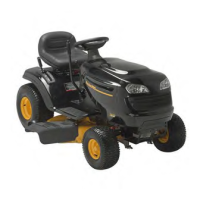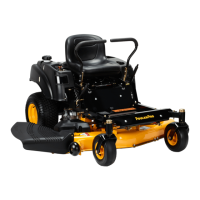Do you have a question about the Poulan Pro 968999302 and is the answer not in the manual?
General overview of the Poulan ride-on mower and manual's importance.
Expresses appreciation for purchasing the Poulan ride-on mower and highlights its efficiency and performance features.
Defines terminology like "left" and "right" and notes that specifications are subject to change without notice.
Advises checking road traffic regulations and using secure fastening equipment when transporting the machine on public roads.
Warns against towing the machine or towing trailers with the mower due to potential damage and injury.
Specifies the intended use for mowing lawns on even ground and emphasizes following manufacturer's directions for operation and maintenance.
Emphasizes Poulan's specialized retail stores for support and service, recommending documentation in the Service Journal.
Explains how to find the machine's and engine's manufacturing numbers for identification and ordering spare parts.
Explains that symbols found on the machine and manual should be studied to understand their meanings.
Displays various warning symbols related to safe operation, such as reading the manual, keeping distance, and avoiding passengers.
Emphasizes the importance of reading and following safety instructions for preventing serious injury or death.
Provides essential safety guidelines for operating the mower, including reading the manual, keeping clear of moving parts, and never carrying passengers.
Covers operating in daylight, avoiding alcohol/drugs, watching for traffic, loading/unloading safety, and age-related injury risks.
Lists essential personal protective equipment like safety glasses, gloves, and ear protectors for safe operation.
Details crucial safety measures for operating on slopes, including maximum angle and avoiding turns.
Outlines critical safety rules to prevent accidents involving children, emphasizing keeping them away from the mowing area.
Highlights safety precautions for maintenance, such as not starting the engine with protective plates removed and safe handling of gasoline.
Provides detailed instructions and warnings for safely handling gasoline, emphasizing fire prevention and avoiding spills.
Covers general maintenance safety, including avoiding enclosed spaces, checking bolts, not tampering with safety devices, and handling batteries.
Details safety measures when working with batteries, including avoiding sparks, proper disconnection, and handling acid.
Outlines crucial safety procedures for loading, unloading, and transporting the machine on vehicles or trailers.
Defines the user's responsibilities, including observing safety rules and following maintenance schedules, and notes spark arrester requirements.
Introduces the Poulan Zero Turn Rider's controls, engine, and transmission system for steering and speed regulation.
Lists specific controls and their corresponding page numbers for detailed explanations within the manual.
Explains how the two steering controls operate the machine's speed and direction, including zero-turn maneuvers.
Advises checking rear tire pressure for proper tracking and contacting a service workshop if adjustments are needed.
Details how to adjust the seat lengthways by loosening and re-tightening the knobs.
Locates the fuses in the engine compartment and lists their ratings and functions.
Explains how to engage EZT bypass linkages for pushing or pulling the mower, and how to reengage for driving.
Covers fuel tank capacity, type of gasoline, and safety warnings related to refueling the machine.
Describes how to engage and disengage the mower deck using the blade switch.
Explains the function of the ignition key for starting and stopping the engine, with starting time limits.
Details the use of the choke control for cold starts to enrich the fuel mixture.
Explains how the throttle control regulates engine speed and blade rotation, recommending full throttle for mowing.
Describes the hour meter's function for displaying operating time and the "CHG OIL" indicator.
Explains the location and operation of the parking brake lever, emphasizing stopping the machine before engagement.
Details how to use the foot pedal to adjust the deck cutting height and the importance of tire pressure for even cutting.
Mentions the availability of a BioClip attachment for mulching.
Encourages reading safety and control sections and suggests training for zero-turn maneuverability on hard surfaces.
Recommends reduced throttle and speed initially, and practicing on hard surfaces to avoid turf damage.
Lists essential checks before starting, including reading manuals, performing daily maintenance, checking fuel, and seat/brake/control positions.
Provides a step-by-step guide for starting the engine, including sitting on the seat, raising the deck, and engaging the parking brake.
Continues the engine starting procedure by disengaging blades, setting steering controls, throttle, and choke if cold.
Completes the starting process by turning the ignition key, releasing it to run, setting engine speed, and includes a warning about exhaust fumes.
Provides detailed instructions on using jumper cables to start the engine from another vehicle's battery, including safety warnings.
Guides on releasing the parking brake, setting steering controls, selecting cutting height, and engaging the mower deck.
Details specific safety instructions and procedures for operating the mower on slopes, including speed and stopping.
Offers advice on mowing techniques, cutting heights, speed, cleaning the deck, and using compressed air.
Provides a step-by-step guide to safely stop the engine, including disengaging the deck, raising it, and removing the key.
Explains how to engage bypass linkages to manually push or pull the mower, including safety warnings.
Presents a comprehensive schedule of maintenance procedures, categorized by daily, weekly, and interval-based tasks.
Lists further maintenance tasks like checking throttle cable, belt condition, and engine oil, with their required intervals.
Details how to clean and maintain the battery, including terminal cleaning, tightening bolts, and recharging.
Focuses on spark plug maintenance, including checking, cleaning, measuring the gap, and proper installation.
Explains how to verify the functionality of the safety system, ensuring the engine only starts/runs under correct conditions.
Advises checking the engine's cooling air intake and adjusting throttle/choke cables for optimal performance.
Details the process for cleaning or replacing the air filter cartridge and pre-filter for optimal engine performance.
Covers replacing the fuel filter, checking tire pressure, and inspecting the parking brake.
States V-belt non-adjustability and details deck belt removal, including safety warnings.
Guides on routing and installing the deck belt around pulleys, including checking belt routing and replacing shields.
Explains the process for removing and installing the EZT belt, warning about fan blades on EZTs.
Emphasizes the importance of sharp, undamaged blades for mowing effect and details replacement steps.
Provides comprehensive safety checks and general guidance before adjusting the mower deck.
Explains how to level the deck side-to-side, including checking tire pressure and measuring distances.
Details the procedure for adjusting the deck front-to-back for optimal cutting quality, emphasizing prior side-to-side leveling.
Guides on adjusting anti-scalp rollers so they are slightly off the ground at the desired cutting height to prevent scalping.
Covers cleaning, washing, checking caster wheels, and inspecting hardware for loose parts.
Provides a visual schedule for lubrication points (grease gun, oil can) and tasks like oil changes and filter changes.
Covers general lubrication procedures, including removing the key, using correct lubricants, and avoiding contact with belts.
Details how to lubricate cables and caster wheels, ensuring smooth operation and proper lubrication.
Explains the initial and subsequent engine oil change intervals (5-8 hours first, then every 50 hours) and safety for hot oil.
Provides a step-by-step guide for draining engine oil, including removing the cap, fitting a hose, and using a container.
Details how to check the engine oil level using the dipstick, including proper insertion and fill marks.
Guides on draining oil, removing the old filter, and installing a new one with a lubricated seal.
States that the transmission is maintenance-free and advises contacting a dealer for leaks.
Lists common causes for the engine failing to start, such as engaged blade switch or dead battery.
Identifies potential issues when the starter motor does not engage, like poor battery contacts or a blown fuse.
Outlines reasons for rough engine running, including faulty carburetor, incorrect choke use, or valve issues.
Suggests causes for a weak engine, like a clogged air filter or defective spark plug.
Lists potential causes for engine overheating, such as clogged cooling fins or engine overload.
Points to poor battery terminal contact as a reason for the battery not charging.
Identifies issues like engaged parking brake or drive belt problems causing slow or no movement.
Lists causes for the mower deck failing to engage, such as loose drive belt or faulty blade switch.
Explains factors leading to uneven mowing, such as tire pressure, blunt blades, or grass build-up.
Identifies loose or unbalanced blades, or a loose engine as causes for machine vibration.
Details steps for preparing the machine for storage, including cleaning, fuel stabilization, and battery care.
Presents the electrical wiring diagram of the mower, identifying components like battery, key switch, and relays.
Lists detailed engine specifications, including manufacturer, type, power, lubrication, and fuel requirements.
Details equipment specifications like cutting width, height, number of blades, and seat type.
Covers productivity rates and overall machine dimensions including weight and height.
Lists available accessories and provides torque specifications for various bolts and fasteners.
Mentions labels fulfilling requirements, including state-specific ones like Californian emission rules.
Outlines the checklist of actions to be performed during delivery service, including charging battery and checking adjustments.
Specifies the first service action required after 5-8 hours of operation, which is changing the engine oil.
Lists maintenance tasks for the 25-hour service, including blade sharpening, caster lubrication, and tire pressure checks.
Details the tasks for the 50-hour service, which includes performing the 25-hour service and changing engine oil.
Lists maintenance actions for the 100-hour service, including oil filter change, spark plug check, and V-belt check.
Outlines the extensive tasks for the 300-hour service, including deck adjustment and engine valve clearance checks.
Summarizes annual maintenance tasks, referencing interval hours for specific actions like cleaning air intake and changing oil.
General overview of the Poulan ride-on mower and manual's importance.
Expresses appreciation for purchasing the Poulan ride-on mower and highlights its efficiency and performance features.
Defines terminology like "left" and "right" and notes that specifications are subject to change without notice.
Advises checking road traffic regulations and using secure fastening equipment when transporting the machine on public roads.
Warns against towing the machine or towing trailers with the mower due to potential damage and injury.
Specifies the intended use for mowing lawns on even ground and emphasizes following manufacturer's directions for operation and maintenance.
Emphasizes Poulan's specialized retail stores for support and service, recommending documentation in the Service Journal.
Explains how to find the machine's and engine's manufacturing numbers for identification and ordering spare parts.
Explains that symbols found on the machine and manual should be studied to understand their meanings.
Displays various warning symbols related to safe operation, such as reading the manual, keeping distance, and avoiding passengers.
Emphasizes the importance of reading and following safety instructions for preventing serious injury or death.
Provides essential safety guidelines for operating the mower, including reading the manual, keeping clear of moving parts, and never carrying passengers.
Covers operating in daylight, avoiding alcohol/drugs, watching for traffic, loading/unloading safety, and age-related injury risks.
Lists essential personal protective equipment like safety glasses, gloves, and ear protectors for safe operation.
Details crucial safety measures for operating on slopes, including maximum angle and avoiding turns.
Outlines critical safety rules to prevent accidents involving children, emphasizing keeping them away from the mowing area.
Highlights safety precautions for maintenance, such as not starting the engine with protective plates removed and safe handling of gasoline.
Provides detailed instructions and warnings for safely handling gasoline, emphasizing fire prevention and avoiding spills.
Covers general maintenance safety, including avoiding enclosed spaces, checking bolts, not tampering with safety devices, and handling batteries.
Details safety measures when working with batteries, including avoiding sparks, proper disconnection, and handling acid.
Outlines crucial safety procedures for loading, unloading, and transporting the machine on vehicles or trailers.
Defines the user's responsibilities, including observing safety rules and following maintenance schedules, and notes spark arrester requirements.
Introduces the Poulan Zero Turn Rider's controls, engine, and transmission system for steering and speed regulation.
Lists specific controls and their corresponding page numbers for detailed explanations within the manual.
Explains how the two steering controls operate the machine's speed and direction, including zero-turn maneuvers.
Advises checking rear tire pressure for proper tracking and contacting a service workshop if adjustments are needed.
Details how to adjust the seat lengthways by loosening and re-tightening the knobs.
Locates the fuses in the engine compartment and lists their ratings and functions.
Explains how to engage EZT bypass linkages for pushing or pulling the mower, and how to reengage for driving.
Covers fuel tank capacity, type of gasoline, and safety warnings related to refueling the machine.
Describes how to engage and disengage the mower deck using the blade switch.
Explains the function of the ignition key for starting and stopping the engine, with starting time limits.
Details the use of the choke control for cold starts to enrich the fuel mixture.
Explains how the throttle control regulates engine speed and blade rotation, recommending full throttle for mowing.
Describes the hour meter's function for displaying operating time and the "CHG OIL" indicator.
Explains the location and operation of the parking brake lever, emphasizing stopping the machine before engagement.
Details how to use the foot pedal to adjust the deck cutting height and the importance of tire pressure for even cutting.
Mentions the availability of a BioClip attachment for mulching.
Encourages reading safety and control sections and suggests training for zero-turn maneuverability on hard surfaces.
Recommends reduced throttle and speed initially, and practicing on hard surfaces to avoid turf damage.
Lists essential checks before starting, including reading manuals, performing daily maintenance, checking fuel, and seat/brake/control positions.
Provides a step-by-step guide for starting the engine, including sitting on the seat, raising the deck, and engaging the parking brake.
Continues the engine starting procedure by disengaging blades, setting steering controls, throttle, and choke if cold.
Completes the starting process by turning the ignition key, releasing it to run, setting engine speed, and includes a warning about exhaust fumes.
Provides detailed instructions on using jumper cables to start the engine from another vehicle's battery, including safety warnings.
Guides on releasing the parking brake, setting steering controls, selecting cutting height, and engaging the mower deck.
Details specific safety instructions and procedures for operating the mower on slopes, including speed and stopping.
Offers advice on mowing techniques, cutting heights, speed, cleaning the deck, and using compressed air.
Provides a step-by-step guide to safely stop the engine, including disengaging the deck, raising it, and removing the key.
Explains how to engage bypass linkages to manually push or pull the mower, including safety warnings.
Presents a comprehensive schedule of maintenance procedures, categorized by daily, weekly, and interval-based tasks.
Lists further maintenance tasks like checking throttle cable, belt condition, and engine oil, with their required intervals.
Details how to clean and maintain the battery, including terminal cleaning, tightening bolts, and recharging.
Focuses on spark plug maintenance, including checking, cleaning, measuring the gap, and proper installation.
Explains how to verify the functionality of the safety system, ensuring the engine only starts/runs under correct conditions.
Advises checking the engine's cooling air intake and adjusting throttle/choke cables for optimal performance.
Details the process for cleaning or replacing the air filter cartridge and pre-filter for optimal engine performance.
Covers replacing the fuel filter, checking tire pressure, and inspecting the parking brake.
States V-belt non-adjustability and details deck belt removal, including safety warnings.
Guides on routing and installing the deck belt around pulleys, including checking belt routing and replacing shields.
Explains the process for removing and installing the EZT belt, warning about fan blades on EZTs.
Emphasizes the importance of sharp, undamaged blades for mowing effect and details replacement steps.
Provides comprehensive safety checks and general guidance before adjusting the mower deck.
Explains how to level the deck side-to-side, including checking tire pressure and measuring distances.
Details the procedure for adjusting the deck front-to-back for optimal cutting quality, emphasizing prior side-to-side leveling.
Guides on adjusting anti-scalp rollers so they are slightly off the ground at the desired cutting height to prevent scalping.
Covers cleaning, washing, checking caster wheels, and inspecting hardware for loose parts.
Provides a visual schedule for lubrication points (grease gun, oil can) and tasks like oil changes and filter changes.
Covers general lubrication procedures, including removing the key, using correct lubricants, and avoiding contact with belts.
Details how to lubricate cables and caster wheels, ensuring smooth operation and proper lubrication.
Explains the initial and subsequent engine oil change intervals (5-8 hours first, then every 50 hours) and safety for hot oil.
Provides a step-by-step guide for draining engine oil, including removing the cap, fitting a hose, and using a container.
Details how to check the engine oil level using the dipstick, including proper insertion and fill marks.
Guides on draining oil, removing the old filter, and installing a new one with a lubricated seal.
States that the transmission is maintenance-free and advises contacting a dealer for leaks.
Lists common causes for the engine failing to start, such as engaged blade switch or dead battery.
Identifies potential issues when the starter motor does not engage, like poor battery contacts or a blown fuse.
Outlines reasons for rough engine running, including faulty carburetor, incorrect choke use, or valve issues.
Suggests causes for a weak engine, like a clogged air filter or defective spark plug.
Lists potential causes for engine overheating, such as clogged cooling fins or engine overload.
Points to poor battery terminal contact as a reason for the battery not charging.
Identifies issues like engaged parking brake or drive belt problems causing slow or no movement.
Lists causes for the mower deck failing to engage, such as loose drive belt or faulty blade switch.
Explains factors leading to uneven mowing, such as tire pressure, blunt blades, or grass build-up.
Identifies loose or unbalanced blades, or a loose engine as causes for machine vibration.
Details steps for preparing the machine for storage, including cleaning, fuel stabilization, and battery care.
Presents the electrical wiring diagram of the mower, identifying components like battery, key switch, and relays.
Lists detailed engine specifications, including manufacturer, type, power, lubrication, and fuel requirements.
Details equipment specifications like cutting width, height, number of blades, and seat type.
Covers productivity rates and overall machine dimensions including weight and height.
Lists available accessories and provides torque specifications for various bolts and fasteners.
Mentions labels fulfilling requirements, including state-specific ones like Californian emission rules.
Outlines the checklist of actions to be performed during delivery service, including charging battery and checking adjustments.
Specifies the first service action required after 5-8 hours of operation, which is changing the engine oil.
Lists maintenance tasks for the 25-hour service, including blade sharpening, caster lubrication, and tire pressure checks.
Details the tasks for the 50-hour service, which includes performing the 25-hour service and changing engine oil.
Lists maintenance actions for the 100-hour service, including oil filter change, spark plug check, and V-belt check.
Outlines the extensive tasks for the 300-hour service, including deck adjustment and engine valve clearance checks.
Summarizes annual maintenance tasks, referencing interval hours for specific actions like cleaning air intake and changing oil.
| Brand | Poulan Pro |
|---|---|
| Model | 968999302 |
| Category | Lawn Mower |
| Language | English |
